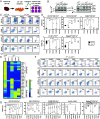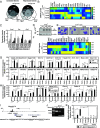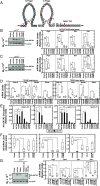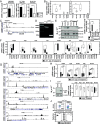Pathogenic GATA2 genetic variants utilize an obligate enhancer mechanism to distort a multilineage differentiation program
- PMID: 38422019
- PMCID: PMC10927522
- DOI: 10.1073/pnas.2317147121
Pathogenic GATA2 genetic variants utilize an obligate enhancer mechanism to distort a multilineage differentiation program
Abstract
Mutations in genes encoding transcription factors inactivate or generate ectopic activities to instigate pathogenesis. By disrupting hematopoietic stem/progenitor cells, GATA2 germline variants create a bone marrow failure and leukemia predisposition, GATA2 deficiency syndrome, yet mechanisms underlying the complex phenotypic constellation are unresolved. We used a GATA2-deficient progenitor rescue system to analyze how genetic variation influences GATA2 functions. Pathogenic variants impaired, without abrogating, GATA2-dependent transcriptional regulation. Variants promoted eosinophil and repressed monocytic differentiation without regulating mast cell and erythroid differentiation. While GATA2 and T354M required the DNA-binding C-terminal zinc finger, T354M disproportionately required the N-terminal finger and N terminus. GATA2 and T354M activated a CCAAT/Enhancer Binding Protein-ε (C/EBPε) enhancer, creating a feedforward loop operating with the T-cell Acute Lymphocyte Leukemia-1 (TAL1) transcription factor. Elevating C/EBPε partially normalized hematopoietic defects of GATA2-deficient progenitors. Thus, pathogenic germline variation discriminatively spares or compromises transcription factor attributes, and retaining an obligate enhancer mechanism distorts a multilineage differentiation program.
Keywords: GATA; GATA2; differentiation; hematopoiesis; transcription.
Conflict of interest statement
Competing interests statement:The authors declare no competing interest.
Figures






Similar articles
-
Human leukemia mutations corrupt but do not abrogate GATA-2 function.Proc Natl Acad Sci U S A. 2018 Oct 23;115(43):E10109-E10118. doi: 10.1073/pnas.1813015115. Epub 2018 Oct 9. Proc Natl Acad Sci U S A. 2018. PMID: 30301799 Free PMC article.
-
Loss of c-Kit and bone marrow failure upon conditional removal of the GATA-2 C-terminal zinc finger domain in adult mice.Eur J Haematol. 2016 Sep;97(3):261-70. doi: 10.1111/ejh.12719. Epub 2016 Jan 14. Eur J Haematol. 2016. PMID: 26660446 Free PMC article.
-
A regulatory network governing Gata1 and Gata2 gene transcription orchestrates erythroid lineage differentiation.Int J Hematol. 2014 Nov;100(5):417-24. doi: 10.1007/s12185-014-1568-0. Epub 2014 Mar 18. Int J Hematol. 2014. PMID: 24638828 Review.
-
Pathogenic human variant that dislocates GATA2 zinc fingers disrupts hematopoietic gene expression and signaling networks.J Clin Invest. 2023 Apr 3;133(7):e162685. doi: 10.1172/JCI162685. J Clin Invest. 2023. PMID: 36809258 Free PMC article.
-
Human GATA2 mutations and hematologic disease: how many paths to pathogenesis?Blood Adv. 2020 Sep 22;4(18):4584-4592. doi: 10.1182/bloodadvances.2020002953. Blood Adv. 2020. PMID: 32960960 Free PMC article. Review.
Cited by
-
Dual mechanism of inflammation sensing by the hematopoietic progenitor genome.Sci Adv. 2025 May 30;11(22):eadv3169. doi: 10.1126/sciadv.adv3169. Epub 2025 May 28. Sci Adv. 2025. PMID: 40435239 Free PMC article.
References
-
- Tsai F. Y., et al. , An early haematopoietic defect in mice lacking the transcription factor GATA-2. Nature 371, 221–226 (1994). - PubMed
MeSH terms
Substances
Grants and funding
LinkOut - more resources
Full Text Sources
Medical

